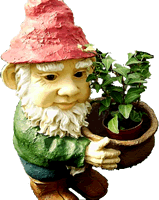How to Repot and Replant Container Grown Plants
This is true whether the plant is classified as a house plant, a perennial, an annual, shrub or tree.
Sooner or later, the roots of a plant growing in a container will fill all of the available space and become rootbound. When this happens, the growth of the plant will slow and eventually stop altogether. The solution is to repot your plant into a larger container.
 |
It is far better to transplant into a new planter that is one size larger than the current pot, rather than a jump to a very large pot to accommodate a small plant. Slow-growing plants may require repotting every two to three years, while faster growing plants should be repotted annually. These instructions are written from the standpoint of a plant which is growing in a standard pot. If your container is large or awkward you will have to adapt them to fit your needs. For instance, tapping the outside of a container with a trowel handle will have the same effect as tapping the rim of the pot against a table. You may have to lay the planter on its side and slide the planter away from the plant rather than inverting it. You get the idea...... |
||
|
Water the plant thoroughly several hours before removing it from the container. This will help to remove the roots from the planter more easily, and reduce transplant shock. Invert the pot holding your hand on the potting mix so the base of the plant is between the index and middle fingers. Tap the rim of the pot on the edge of a table until the root ball slides out of the container. Never pull on the stem of the plant to remove it! Continue tapping or rolling the pot until until the roots slide out on their own. Sometimes you can force the plant from the pot using water pressure from a hose held tightly against the drain hole. In extreme cases it may be necessary to cut or break the pot to release the roots. When the roots grew out and reached the pot, they turned and began growing back into the ball. Once they are part of the mass it is hard for them to reverse direction again. It is necessary to give them a little help to get going on the right track again. Use your finger tips to carefully loosen the roots at the base and along the side of the root ball to allow them to grow into the new soil. If the root ball is extremely knotted and tight, it may be advisable to use a sharp knife and cut some of the entangled roots to separate them by making a 1/8 to 1/4 slice down the side of the root ball or gently, but forcibly separate the base of the ball. Use care not to damage any main 'tap' roots. Before repotting, prune off any dead or damaged roots. Place a small piece of broken clay pot over any drainage holes in the new planter to keep soil from draining through the hole. If there are no drainage holes, add an inch or two of clean gravel to the bottom of the planter. Add potting mix into the container to a point that when the root ball is set in, it will come to within an inch of the top of the pot. Gently set the plant into the container. Center it and 'face it' in the direction which best shows off it's beauty. Be certain it is standing straight and begin adding potting mix around the root ball, tamping it lightly until you have filled the gaps and slightly covered the top of the root ball. Be sure to leave at least 3/4 of an inch at the top of the pot for watering. Water the plant well to get good soil contact with the roots (air pockets can lead to problems). Do not water again until the soil is almost dry. Help your plant to avoid transplant shock, by gradually bringing it back into full light rather than immediately putting it into full sun. Keep it in a warm area for a few days (Not Hot!). Adding a soluble transplant fertilizer to the water will help the roots to recover and begin growing again sooner. The Potting Soil Mix
| |||

Search The Garden Helper: